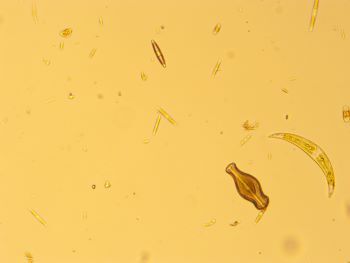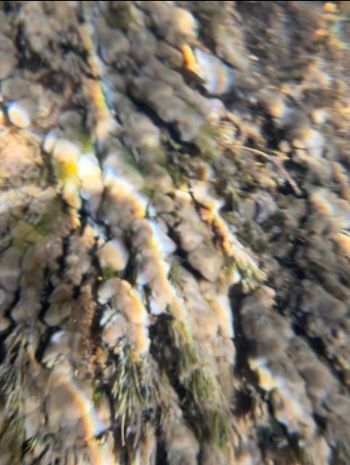|
May 02, 2024
Contact: Bryan Burroughs, Michigan Trout Unlimited, 517-599-5238 or Billy Keiper, EGLE, 517-342-4087
Anglers and paddlers urged to decontaminate waders, watercraft and gear
Didymo cells have been found in algae samples taken from submerged rocks and debris at two boating access sites on the Au Sable River north of Luzerne in Oscoda County, Michigan.
Sampling conducted by Michigan Trout Unlimited in late April found several didymo cells at the Parmalee Canoe Launch off North Red Oak Road and one cell just downstream at the Whirlpool access off West Cherry Creek Road. No evidence of didymo was found in samples taken upstream at the McMasters Bridge Road access, further downstream or in a number of tributaries sampled to date.

Didymo, also known as “rock snot,” is a microscopic diatom (single-celled alga) that thrives in cold, low-nutrient streams generally considered pristine. Under the right conditions, cells can form extensive stalks, or blooms, creating dense mats that cover the stream bed and reduce habitat for macroinvertebrates including mayfly, caddisfly and stonefly nymphs, which are crucial food sources for fish.
Though no blooms have been observed at either of the two Au Sable River access sites, Michigan Trout Unlimited is joining the Michigan departments of Natural Resources and Environment, Great Lakes, and Energy to urge anglers and all stream users to properly clean waders, boats and equipment between every site visit.
|

“With trout season now open across the state and paddle sports gearing up for the summer, it’s important to remind everyone enjoying Michigan’s streams and rivers to take steps to decontaminate to prevent further spread of didymo and aquatic invasive species,” said Bryan Burroughs, executive director of Michigan Trout Unlimited.
Didymo is believed to be native to at least parts of the Great Lakes basin; however, its exact native range is unknown. Blooms are recent phenomena first observed in Michigan waters in 2015 in the St. Marys River and then in the Manistee and Boardman rivers in 2021 and 2022, respectively. Scientists are still researching the causes of blooms.
Didymo blooms appear to be sporadic and do not persist throughout the entire year or every fishing season. This provides some relief, but vigilance and decontamination efforts remain important to reduce harmful effects on streams.
|
What is being done
Though there is no known treatment for didymo, efforts to understand its extent and behavior in Michigan waters are ongoing.
- Since 2021, EGLE and partners have monitored for didymo at 40 locations across 12 of the most popular trout streams in the northern Lower Peninsula, looking for cells and low-level blooms at heavily used access locations.
- A local researcher found didymo in low abundance in the Rapid River near Rapid City in Kalkaska County in 2023; however, further investigation did not find didymo elsewhere in that watershed.
- Michigan Trout Unlimited began monitoring rivers for didymo presence in August 2023 and has collected and analyzed 32 algal scrapings from river bottoms, leading to this new detection in the Au Sable River.
- Researchers at Lake Superior State University have been investigating the use of environmental DNA, or eDNA, for didymo early detection and are using an experimental stream setup to manipulate nutrient conditions to further understand what may causing didymo blooms.
- Many bait and tackle shops, outfitters and organizations like Michigan Trout Unlimited are helping the DNR and EGLE share information on proper decontamination techniques with river and stream users across the state.
- Michigan Trout Unlimited, in partnership with the DNR and EGLE, has submitted a proposal for Great Lakes Restoration Initiative funding that would increase the capacity for additional didymo monitoring across Michigan.
How to decontaminate
To prevent didymo and other damaging species from hitchhiking on your waders, watercraft and gear, pack a scrub brush, towels and a chemical disinfectant for use when you exit the water.
Always Clean, Drain and Dry your waders, boots, boats and other gear between trips or before moving to a new body of water. Using different gear for each stream can reduce the potential for spread.
Take extra precaution in areas with known or suspected didymo or invasive species. In addition to removing debris and mud, the State of Michigan recommends using a chemical disinfectant to achieve maximum decontamination for didymo and invasives like New Zealand mudsnail. Disinfectants with documented effectiveness for these species include:
- Products such as Formula 409 Antibacterial All-Purpose Cleaner: Apply to waders and gear and allow to soak for at least five minutes.
- Bleach: Apply a solution equivalent to 1 ounce of bleach per 1 gallon of water (at least a 2% bleach solution) and let stand for 20 minutes.
- Virkon Aquatic: Apply a solution of 20 grams per liter of water and let stand for 20 minutes (see manufacturer’s label for additional guidance).
Any chemical disinfectants should be applied to waders and gear on land, at a reasonable distance from the water, to avoid accidentally getting the disinfectants into surface waters.
Michigan Trout Unlimited’s pamphlet, “Stopping the Spread of New Zealand Mudsnails,” provides additional guidance on decontamination for anglers.
Research into the effectiveness of products such as Formula 409 Antibacterial All-Purpose Cleaner as a decontaminant for other aquatic species and diseases is ongoing. The Michigan Invasive Species Program will update its recommendations, as needed, based on the best available information to prevent the spread of aquatic invasive species.
Report new detections
Public reporting plays an important role in early detection of invasive and nuisance species. Anyone encountering suspected didymo in new locations is asked to photograph and report the find.
To report didymo, use the Eyes in the Field online reporting system. Be sure to include up to three photos to aid in verification.
For more information on decontamination or aquatic invasive species, visit Michigan.gov/Invasives.
Michigan's Invasive Species Program is cooperatively implemented by the Michigan departments of Agriculture and Rural Development; Environment, Great Lakes, and Energy; and Natural Resources.
Note to editors: Accompanying photos are available below for download. Caption information follows.
Cell: Magnification of a didymo cell, (bottom right) evident by its “coke bottle” shape, from a Parmalee Canoe Launch access site sample. Photo courtesy of Michigan Trout Unlimited.
Didymo veg: Didymo covers vegetation in an area of the Boardman River. Photo courtesy of Michigan Department of Environment, Great Lakes, and Energy.
|